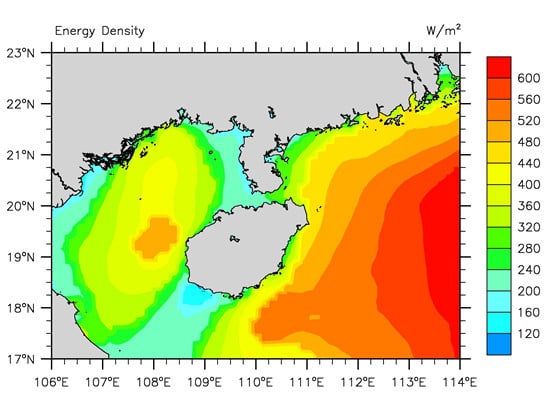Offshore Wind Resources Assessment from Multiple Satellite Data and WRF Modeling over South China Sea
Abstract
:1. Introduction
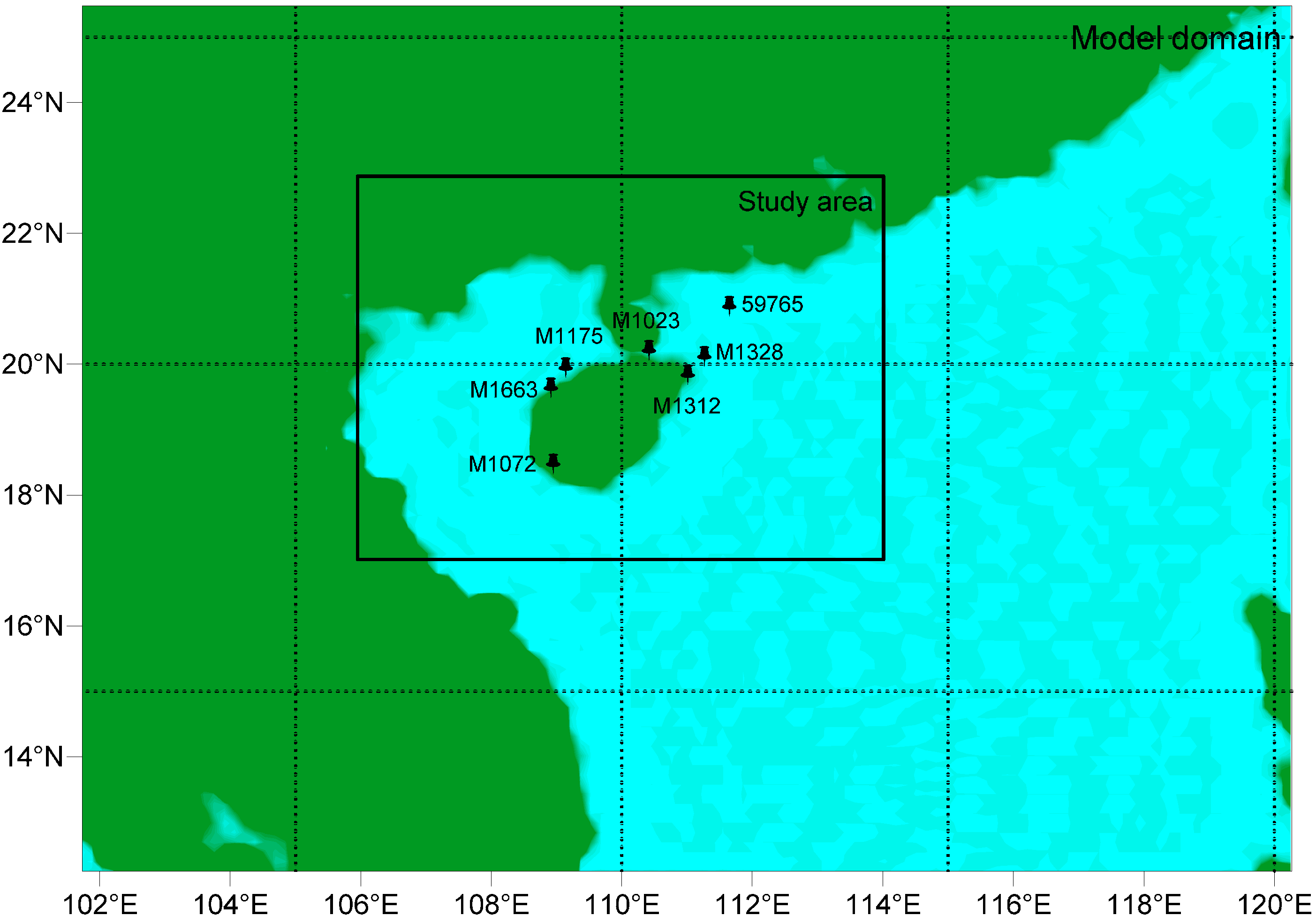
2. Data and Methods
2.1. SAR Satellite Images and Wind Retrieval Method

| Year | Number of Scenes | Month | Number of Scenes |
|---|---|---|---|
| 2003 | 1 | January | 35 |
| 2004 | 1 | February | 27 |
| 2005 | 12 | March | 39 |
| 2006 | 29 | April | 33 |
| 2007 | 62 | May | 36 |
| 2008 | 90 | June | 38 |
| 2009 | 58 | July | 53 |
| 2010 | 83 | August | 37 |
| 2011 | 100 | September | 34 |
| 2012 | 24 | October | 40 |
| November | 53 | ||
| December | 35 |
2.2. Scatterometer Wind Vectors
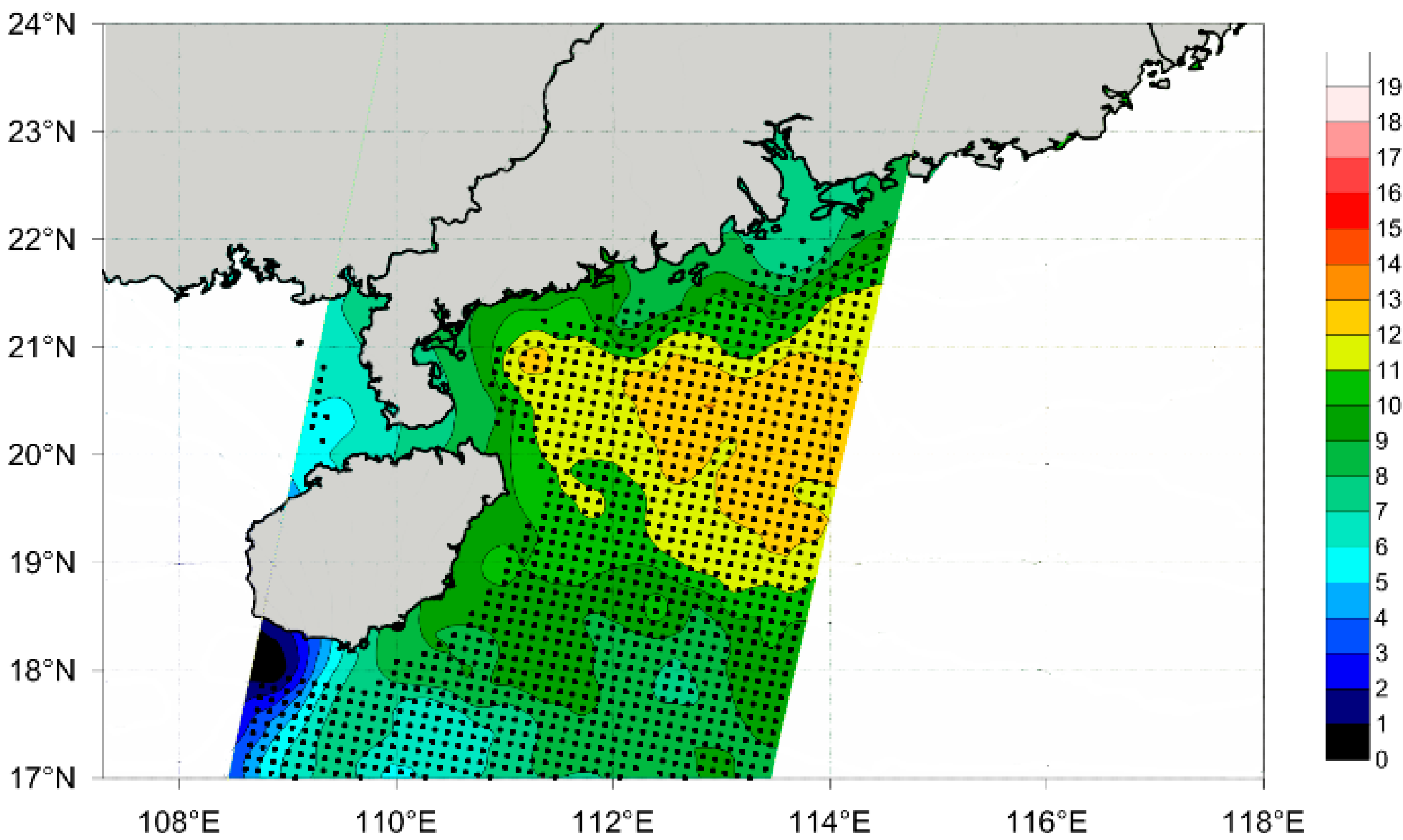
| Year | 2009 | 2010 | 2011 | 2012 | 2013 |
|---|---|---|---|---|---|
| Num of ASCAT scenes | 1074 | 1282 | 1263 | 1297 | 662 |
2.3. Wind Observations from Meteorological Stations
| Met Mast | H | D | Observation Period |
|---|---|---|---|
| 59765 | 0 | −88 | 2010-07-23~2012-12-31 |
| M1328 | 0 | −31.5 | 2010-05-04~2012-12-31 |
| M1072 | 0 | −5.42 | 2010-04-27~2012-10-12 |
| M1175 | 0 | −2.2 | 2009-01-01~2012-10-12 |
| M1312 | 0 | 0.05 | 2007-07-18~2012-10-12 |
| M1023 | 3 | 0.14 | 2007-12-26~2012-10-12 |
| M1663 | 8 | 0.48 | 2007-11-19~2012-10-12 |
2.4. WRF Model Setup
2.4.1. Control Simulation
| Model Setup: |
|---|
| WRF (ARW) Version 3.4 Model domain (121 × 92 grid points) with 15 km grid spacing on a Mercator projection (Figure 1). 36 vertical levels with model top at 50 hPa; eight of these levels are placed within 300 m of the surface. |
| Simulation Setup: |
| Initial, boundary conditions, and fields for grid nudging come from the NCEP Climate Forecast System Reanalysis data at 0.5° × 0.5° resolution [21]. Sea surface temperature (SST) and sea-ice fractions come from the dataset produced at USA NOAA/NCEP at 1/12° × 1/12° resolution [22] and are updated daily. Runs are started (cold start) at 00:00 UTC every 10 days and are integrated for 11 days, the first 24 h of each simulation are disregarded. Model output: Hourly. Time step in most simulations: 90 s. Grid nudging on model domain; nudging coefficient 0.0003 s−1 for wind, temperature and specific humidity. |
| Physical Parameterizations: |
| Precipitation: Thompson graupel scheme (option 8), Kain-Fritsch cumulus parameterization (option 1). Radiation: RRTM scheme for long-wave (option 1); Dudhia scheme for shortwave (option 1). PBL and land surface: Mellor-Yamada-Janjic scheme (option 2), Eta similarity (option 2) surface-layer scheme, and Noah Land Surface Model (option 2). Diffusion: Simple diffusion (option 1); 2D deformation (option 4); 6th order positive definite numerical diffusion (option 2); rates of 0.06; no vertical damping. Positive definite advection of moisture and scalars. |
2.4.2. Assimilation
3. Spatial Averaging and Post-Processing Procedure
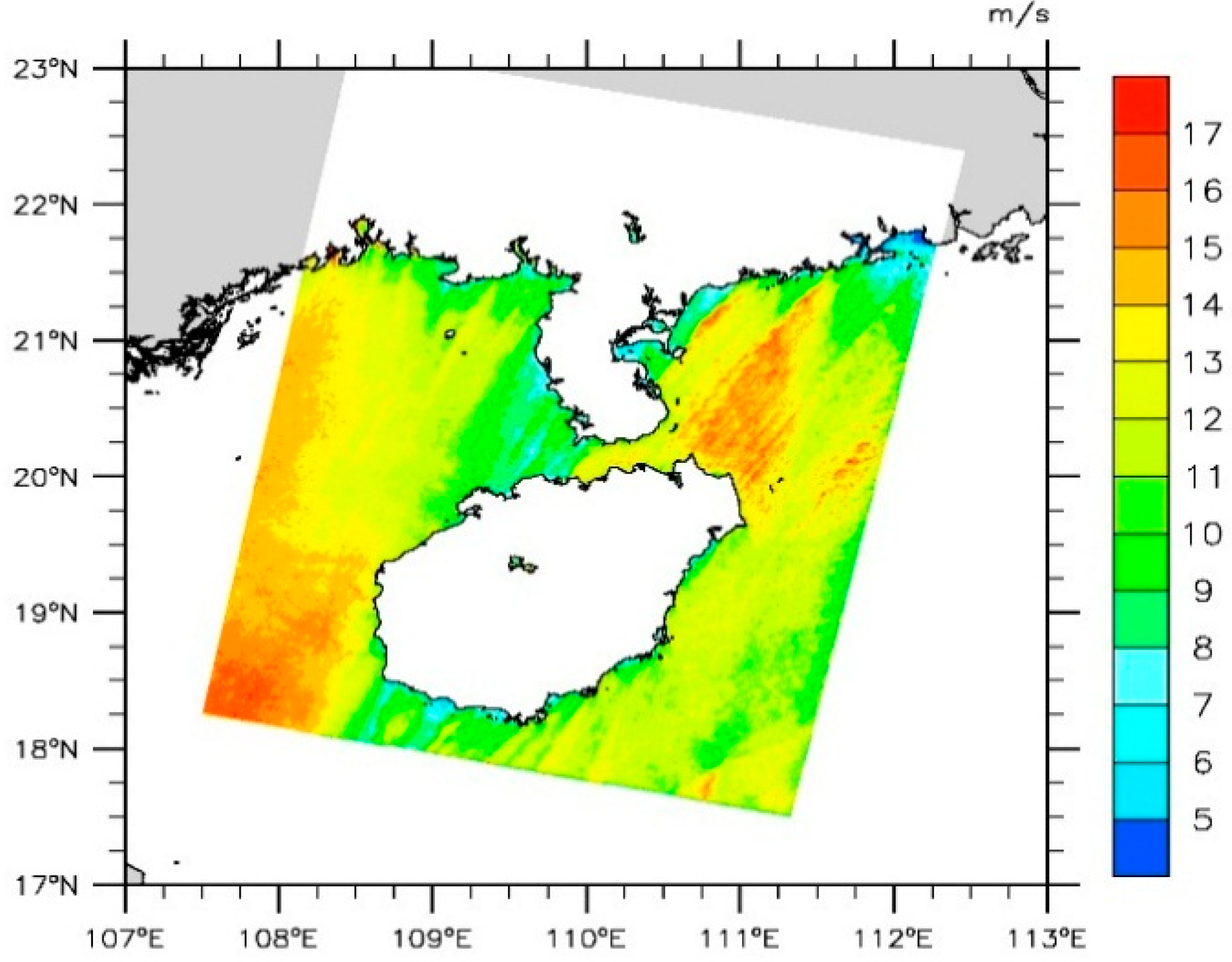
4. Wind Resource Statistics
5. Validation Results
5.1. Wind Direction between In Situ Data vs. SAR
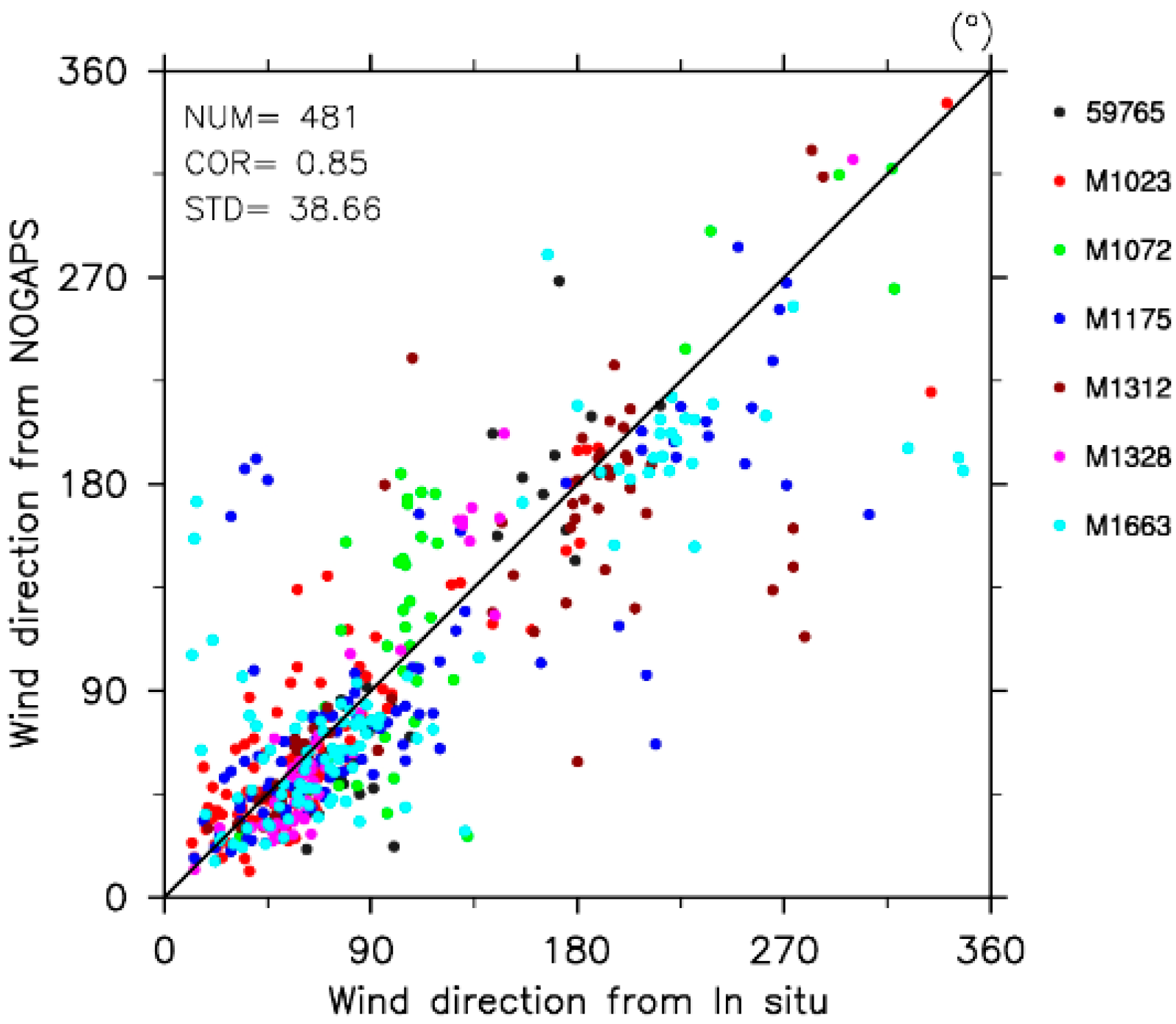
5.2. Wind Speed between In Situ Data vs. SAR
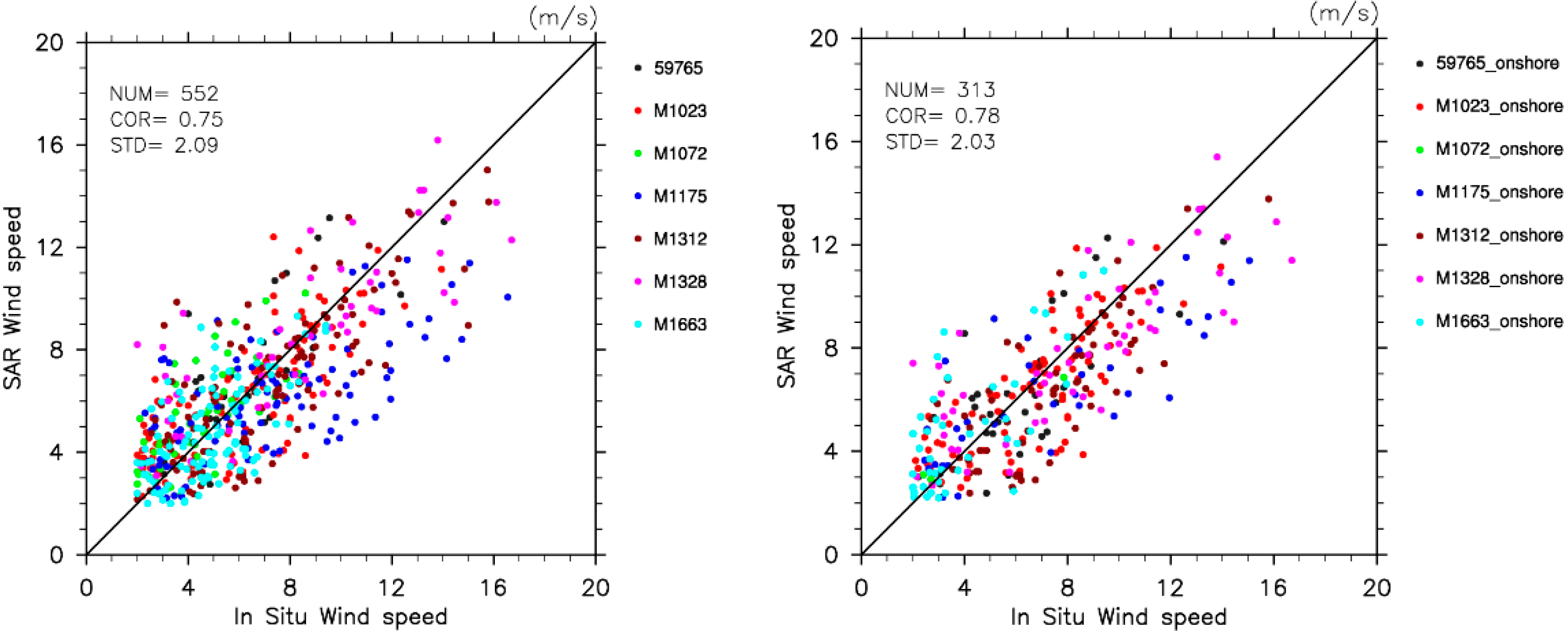
| Station No. | N | R | SD (m/s) | ME (m/s) |
|---|---|---|---|---|
| 59765 | 31 | 0.74 | 2.00 | 0.67 |
| M1328 | 50 | 0.81 | 2.37 | −0.01 |
| M1072 | 52 | 0.72 | 1.41 | 0.84 |
| M1175 | 99 | 0.67 | 2.5 | −0.46 |
| M1312 | 108 | 0.77 | 2.09 | −1.34 |
| M1023 | 106 | 0.74 | 1.86 | −0.07 |
| M1663 | 106 | 0.62 | 1.55 | −0.20 |
| All | 552 | 0.75 | 2.09 | −0.27 |
5.3. Wind between Scatterometer Data and In Situ Data
| Station No. | N | R | SD (m/s) | ME (m/s) |
|---|---|---|---|---|
| 59765 | 358 | 0.79 | 1.77 | −0.32 |
| M1328 | 64 | 0.82 | 2.13 | −0.85 |
| All | 422 | 0.80 | 1.83 | −0.40 |
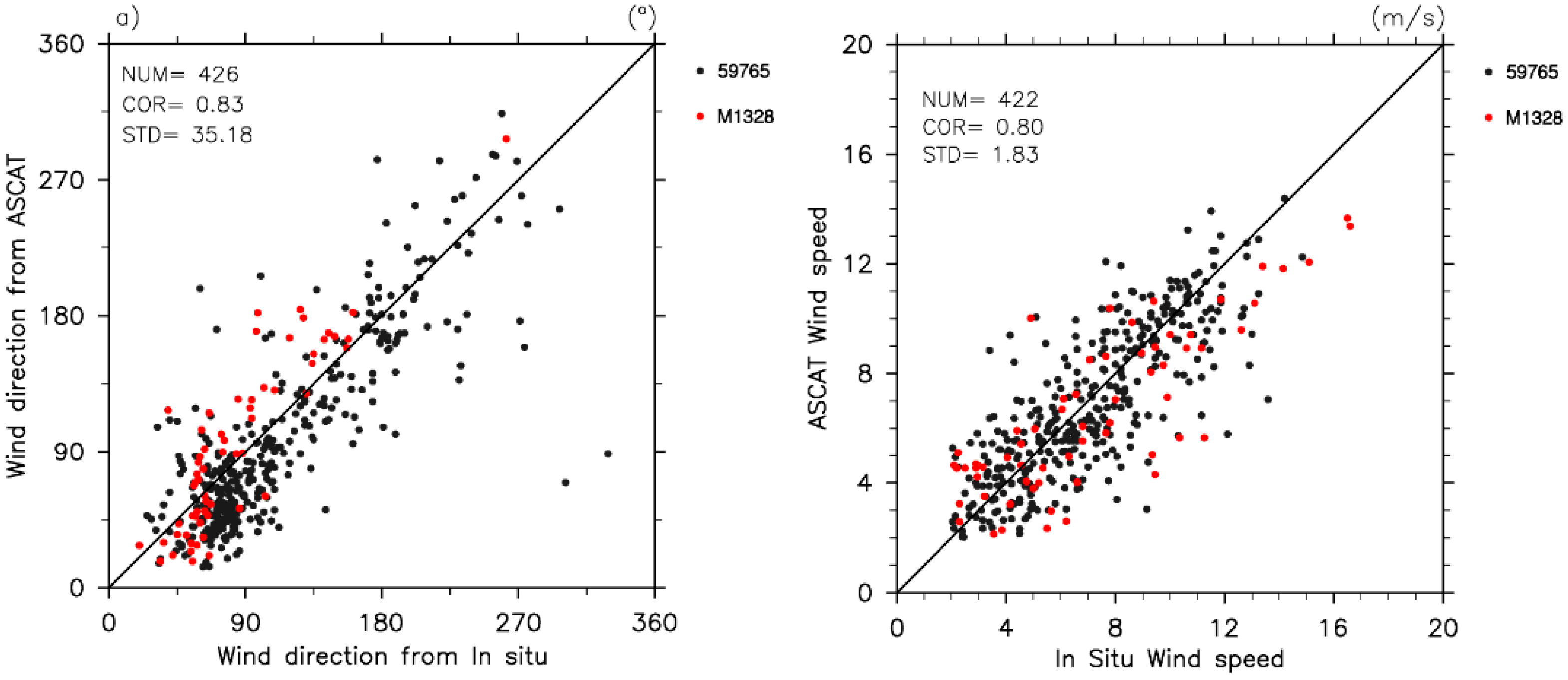
5.4. Weibull Parameter Based on Satellite Data
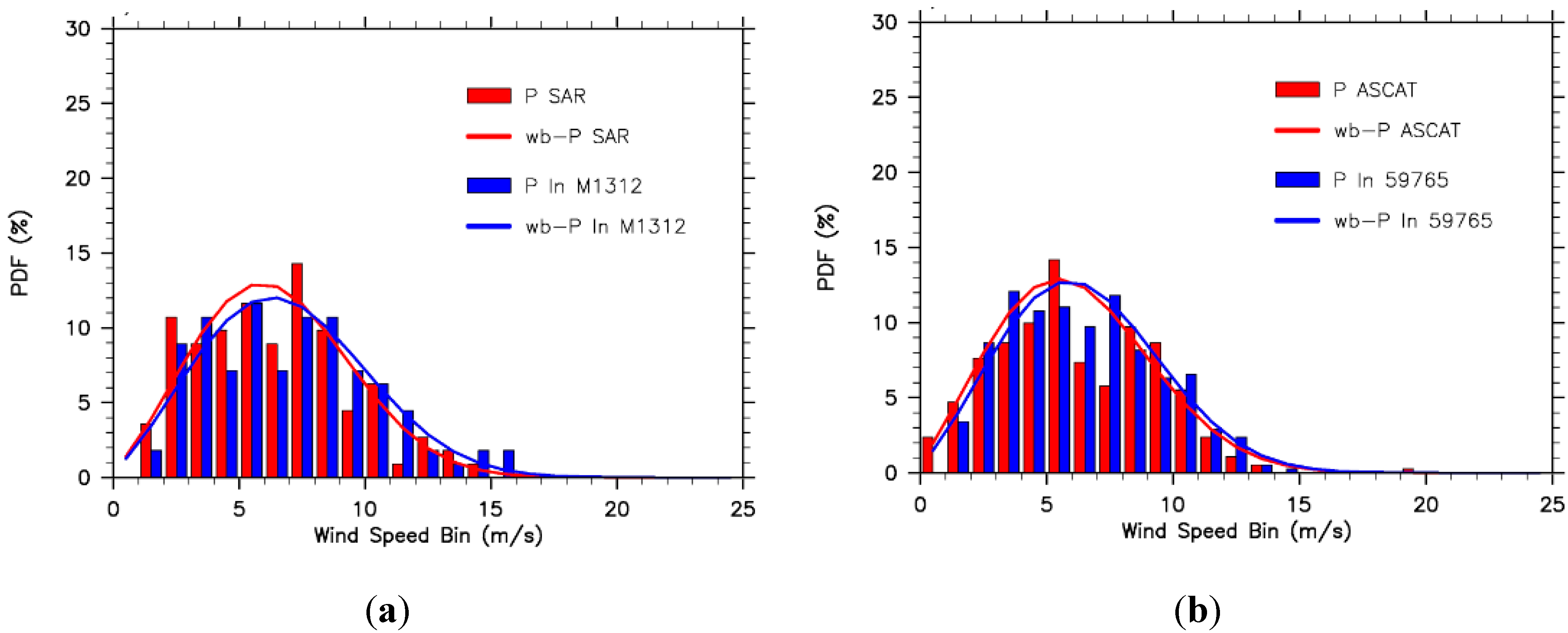
6. Satellite Data Assimilation
| Station Location | N | Statistical Variables | Control Run | Assimilation Run |
|---|---|---|---|---|
| (115.5°E, 20.5°N) | 242 | correlation coefficient | 0.85 | 0.96 |
| RMSE (m/s) | 1.94 | 0.93 | ||
| (108.5°E, 18.7°N) | 270 | correlation coefficient | 0.86 | 0.91 |
| RMSE | 1.91 | 1.57 | ||
| (111.8°E, 19.5°N) | 226 | correlation coefficient | 0.92 | 0.96 |
| RMSE (m/s) | 1.36 | 0.97 | ||
| (108.0°E, 20.0°N) | 300 | correlation coefficient | 0.89 | 0.96 |
| RMSE (m/s) | 1.50 | 1.00 | ||
| (108.0°E, 17.5°N) | 290 | correlation coefficient | 0.80 | 0.90 |
| RMSE (m/s) | 1.89 | 1.29 | ||
| (112.0°E, 18.5°N) | 250 | correlation coefficient | 0.92 | 0.95 |
| RMSE (m/s) | 1.39 | 1.05 | ||
| (108.0°E, 20.0°N) | 299 | correlation coefficient | 0.89 | 0.96 |
| RMSE (m/s) | 1.87 | 1.10 | ||
| (107.0°E, 19.0°N) | 300 | correlation coefficient | 0.85 | 0.95 |
| RMSE (m/s) | 1.93 | 1.02 | ||
| (103.0°E, 19.0°N) | 237 | correlation coefficient | 0.91 | 0.96 |
| RMSE (m/s) | 1.54 | 1.02 | ||
| (109.0°E, 20.2°N) | 290 | correlation coefficient | 0.86 | 0.92 |
| RMSE (m/s) | 1.86 | 1.35 |
| Station No. | Validation Results of SAR Wind Assimilation | Validation Results of ASCAT Wind Assimilation | ||||||
|---|---|---|---|---|---|---|---|---|
| NS | RMSEct (m/s) | RMSEda (m/s) | ΔRMSE (m/s) | NA | RMSEct (m/s) | RMSEda (m/s) | ΔRMSE (m/s) | |
| 59765 | 48 | 8.58 | 5.71 | −2.87 | 410 | 5.91 | 3.95 | −1.96 |
| M1328 | 33 | 7.08 | 7.81 | 0.73 | 369 | 7.34 | 6.62 | −0.72 |
| M1072 | 57 | 7.37 | 5.94 | −1.43 | 521 | 6.69 | 5.63 | −1.06 |
| M1175 | 42 | 6.62 | 8.11 | 1.49 | 588 | 5.61 | 6.04 | 0.43 |
| M1312 | 58 | 7.10 | 5.10 | −2 | 598 | 4.30 | 4.59 | 0.29 |
| M1023 | 47 | 5.53 | 5.17 | −0.36 | 368 | 4.45 | 4.87 | 0.42 |
| M1663 | 77 | 6.44 | 4.65 | −1.79 | 539 | 7.34 | 6.07 | −1.27 |
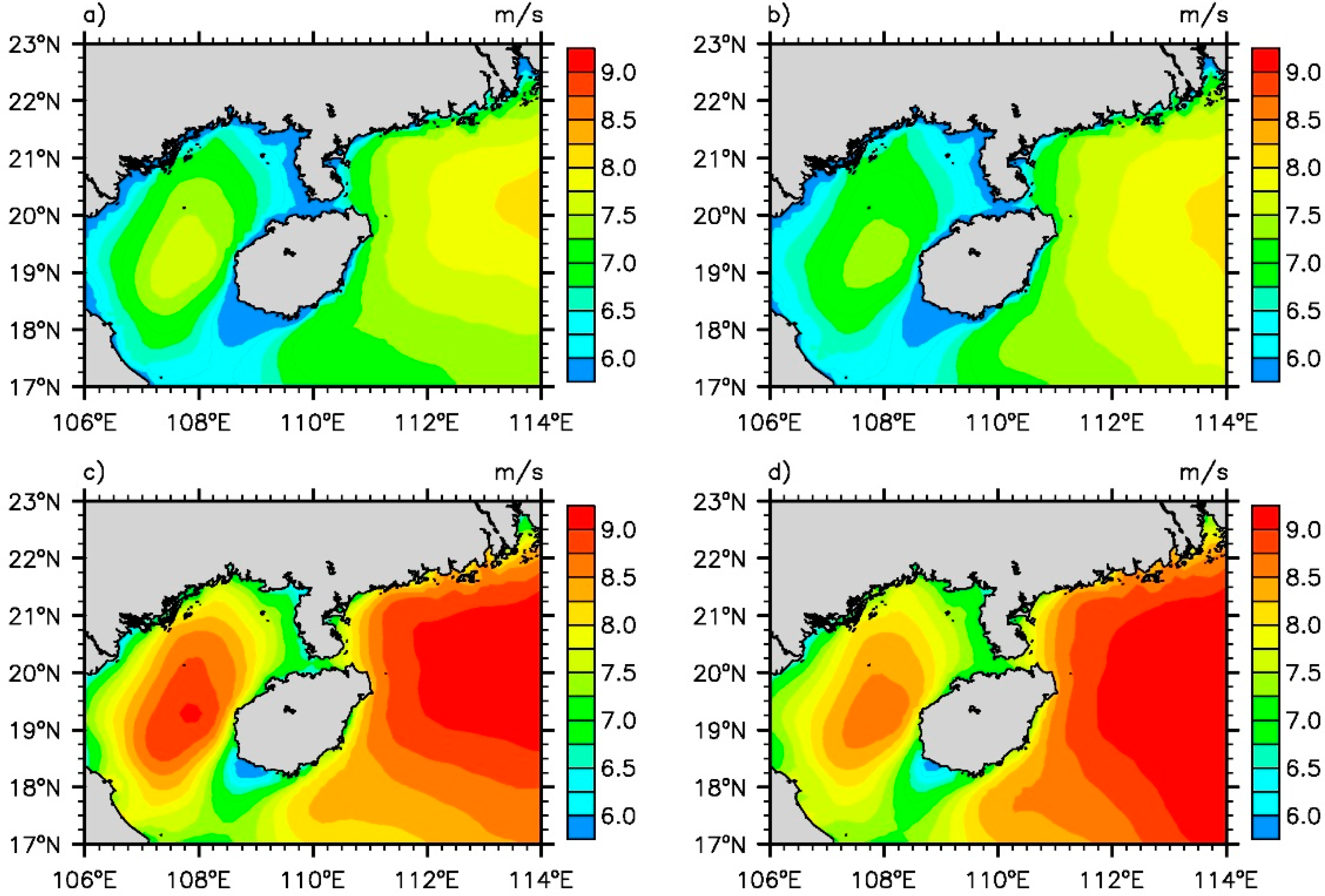
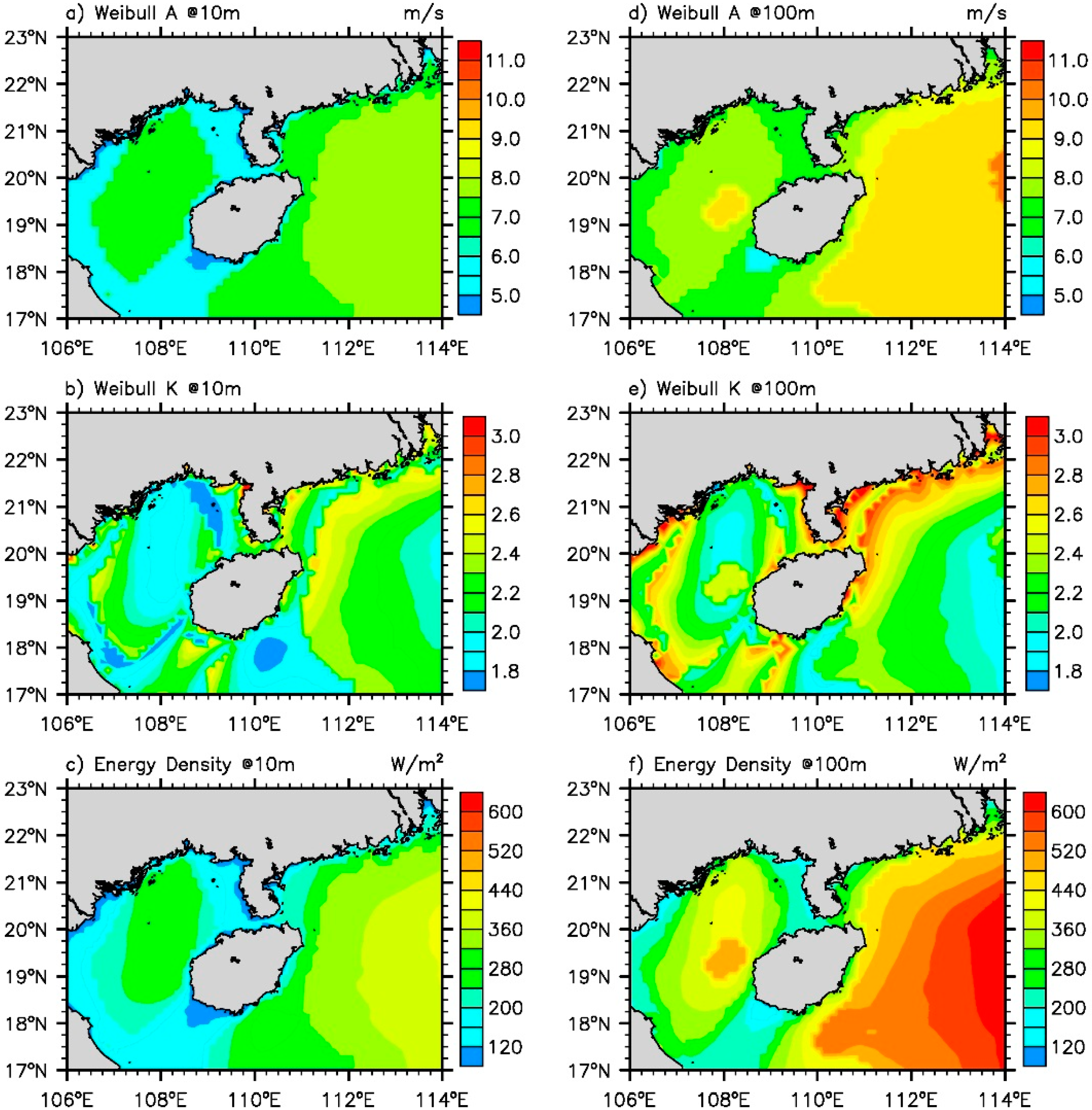
7. Discussions
8. Conclusions
Acknowledgements
Author Contributions
Conflicts of Interest
References
- Hasager, C.B.; Barthelmie, R.J.; Christiansen, M.B. Quantifying offhsore wind resources from satellite wind maps: Study area the North Sea. Wind Energy 2006, 9, 63–74. [Google Scholar] [CrossRef]
- Troen, I.; Petersen, E.L. European Wind Atlas. Available online: https://www.etde.org/etdeweb/details_open.jsp?osti_id=5920204 (accessed on 23 August 2014).
- Christiansen, M.B.; Koch, K.; Horstmann, J.; Hasager, C.B.; Nielsen, M. Wind resource assessment from C-band SAR. Remote Sens. Environ. 2006, 105, 68–81. [Google Scholar] [CrossRef]
- Dagestad, K.F.; Horstmann, J.; Mouche, A.; Perrie, W.; Shen, H.; Zhang, B.; Li, X.; Monaldo, F.; Pichel, W.; Lehner, S.; et al. Wind Retrieval from Synthetic Aperture Radar—An Overview. Available online: http://orbit.dtu.dk/ws/files/59267621/SeaSAR2012_whitepaper_wind.pdf (accessed on 23 August 2014).
- Xu, J.W.; Yong, L.; Zhang, X.Z.; Zhu, R. China offshore wind energy resources assessment with the QuickSCAT data. In Proceedings of the SPIE Remote Sensing of the Ocean, Sea Ice and Large Water Regions, Cardiff, UK, 13–15 September 2008.
- Chou, K.-H.; Wu, C.-C.; Lin, S.-Z. Assessment of the ASCAT wind error characteristics by global dropwindsonde observations. J. Geophys. Res. 2013, 118, 9011–9021. [Google Scholar]
- Johannessen, J.A. Coastal Observing Systems: The Role of Synthetic Aperture Radar. Available online: http://www.jhuapl.edu/techdigest/TD/td2101/johann.pdf (accessed on 23 August 2014).
- Hasager, C.B.; Nielsen, M.; Astrup, P. Offshore wind resource estimation from satellite SAR wind field maps. Wind Energy 2005, 8, 403–419. [Google Scholar] [CrossRef]
- Hasager, C.B.; Christiansen, M.B.; Peña, A.; Larsén, X.G.; Bingöl, F. SAR-Based wind resource statistics in the Baltic Sea. Remote Sens. 2011, 3, 117–144. [Google Scholar] [CrossRef]
- Horstmann, J.; Schiller, H.; Schulz-Stellenfleth, J.; Lehner, S. Global wind speed retrieval form SAR. IEEE Trans. Geosci. Remote Sens. 2003, 41, 2277–2286. [Google Scholar] [CrossRef]
- Monaldo, F.M.; Thompson, D.R.; Pichel, W.G.; Clemente-Colon, P. A systematic comparison of QuickSCAT and SAR ocean surface wind speeds. IEEE Trans. Geosci. Remote Sens. 2004, 42, 283–291. [Google Scholar] [CrossRef]
- Ebuchi, N.; Graber, H.C.; Caruso, M.J. Evaluation of wind vectors observed by QuikSCAT/SeaWinds using ocean buoy data. J. Atmos. Ocean. Tech. 2002, 19, 2049–2062. [Google Scholar] [CrossRef]
- Pickett, M.H.; Tang, W.; Rosenfeld, L.K. QuikSCAT satellite comparisons with nearshore buoy wind data off the U.S. West Coast. J. Atmos. Ocean. Tech. 2003, 20, 1869–1979. [Google Scholar] [CrossRef]
- Li, J.; Wang, D.X.; Chen, J. Comparison of remote sensing data with in-situ wind observation during the development of the South China Sea monsoon. Chin. J. Ocean. Limnol. 2012, 30, 933–943. [Google Scholar] [CrossRef]
- Christiansen, M.B; Badger, J.; Nielsen, M.; Hasager, C.B.; Peña, P. Wind class sampling of satellite SAR imagery for offshore wind resource mapping. J. Appl. Meteorol. Clim. 2010, 49, 2474–2491. [Google Scholar] [CrossRef]
- Hersbach, H. Comparison of C-band scatterometer CMOD5.N equivalent neutral winds with ECMWF. J. Atmos. Ocean. Tech. 2010, 27, 721–736. [Google Scholar] [CrossRef]
- Liu, W.T.; Tang, W. Equivalent Neutral Wind; Jet Propulsion Laboratory: Pasadena, CA, USA, 1996. [Google Scholar]
- Portabella, M.; Stoffelen, A.C.M. On scatterometer ocean stress. J. Atmos. Ocean. Tech. 2009, 26, 368–382. [Google Scholar] [CrossRef]
- Mouche, A.A.; Hauser, D.; Daloze, J.F.; Guerin, C. Dual-polarization measurements at C-band over the ocean: Results from airborne radar observations and comparison with ENVISAT ASAR data. IEEE Trans. Geosci. Remote Sens. 2005, 43, 753–769. [Google Scholar] [CrossRef]
- Hahmann, A.N.; Vincent, C.L.; Pena, A. Wind Climate Estimation Using WRF Model Output: Method and Model Sensitivities over the Sea. Available online: http://www.readcube.com/articles/10.1002%2Fjoc.4217?r3_referer=wol&tracking_action=preview_click&show_checkout=1 (accessed on 23 August 2014).
- CISL Research Data Archive. Available online: http://rda.ucar.edu/datasets/ (accessed on 23 August 2014).
- Gemmill, W.; Katz, B.; Li, X. Daily Real-Time Global Sea Surface Temperature High Resolution Analysis at NOAA/NCEP. Available online: http://polar.ncep.noaa.gov/sst (accessed on 20 August 2014).
- William, C.S.; Joseph, B.K.; Jimy, D.; David, O.G.; Dale, M.B.; Michael, G.D.; Huang, X.Y.; Wang, W.; Jordan, G.P. A Description of the Advanced Research WRF Version 3. Available online: http://funnel.sfsu.edu/students/luyilin/Lu_Yilin/FALL%202014/Thesis/arw_v3_bw.pdf (accessed on 23 August 2014).
- Lorenc, A.C. Analysis methods for numerical weather prediction. Q. J. Roy. Meteor. Soc. 1986, 112, 1177–1194. [Google Scholar] [CrossRef]
- Larsén, X.G.; Badger, J.; Hahmann, A.N. The selective dynamical downscaling method for extreme-wind atlases. Wind Energy 2013, 16, 1167–1182. [Google Scholar] [CrossRef]
- Tennekes, H. Similarity relations, scaling laws and spectral dynamics. Atmos. Turbul. Air Pollut. Model. 1982, 1, 37–68. [Google Scholar]
- Landberg, L.; Myllerup, L.; Rathmann, O.; Petersen, E.L.; Jørgensen, B.H.; Badger, J.; Mortensen, N. Wind resource estimation—An overview. Wind Energy 2003, 6, 261–271. [Google Scholar] [CrossRef]
- Barthelmie, R.J.; Pryor, S.C. Can satellite sampling of offshore wind speeds realistically represent wind speed distributions? J. Appl. Meteorol. 2003, 42, 83–94. [Google Scholar] [CrossRef]
- Liu, C.X.; Wang, J.; Qi, Y.Q.; Wan, Q.L. A Preliminary study on QuikSCAT wind data assimilation using model WRF. J. Trop. Oceanogr. 2004, 23, 69–74. [Google Scholar]
- Chang, R.; Zhu, R.; Badger, M.; Hasager, C.B.; Zhou, R.; Ye, D.; Zhang, X. Applicability of Synthetic Aperture Radar wind retrievals on offshore wind resources assessment in Hangzhou Bay, China. Energies 2014, 7, 3339–3354. [Google Scholar] [CrossRef]
© 2015 by the authors; licensee MDPI, Basel, Switzerland. This article is an open access article distributed under the terms and conditions of the Creative Commons Attribution license (http://creativecommons.org/licenses/by/4.0/).
Share and Cite
Chang, R.; Zhu, R.; Badger, M.; Hasager, C.B.; Xing, X.; Jiang, Y. Offshore Wind Resources Assessment from Multiple Satellite Data and WRF Modeling over South China Sea. Remote Sens. 2015, 7, 467-487. https://doi.org/10.3390/rs70100467
Chang R, Zhu R, Badger M, Hasager CB, Xing X, Jiang Y. Offshore Wind Resources Assessment from Multiple Satellite Data and WRF Modeling over South China Sea. Remote Sensing. 2015; 7(1):467-487. https://doi.org/10.3390/rs70100467
Chicago/Turabian StyleChang, Rui, Rong Zhu, Merete Badger, Charlotte Bay Hasager, Xuhuang Xing, and Yirong Jiang. 2015. "Offshore Wind Resources Assessment from Multiple Satellite Data and WRF Modeling over South China Sea" Remote Sensing 7, no. 1: 467-487. https://doi.org/10.3390/rs70100467
APA StyleChang, R., Zhu, R., Badger, M., Hasager, C. B., Xing, X., & Jiang, Y. (2015). Offshore Wind Resources Assessment from Multiple Satellite Data and WRF Modeling over South China Sea. Remote Sensing, 7(1), 467-487. https://doi.org/10.3390/rs70100467






